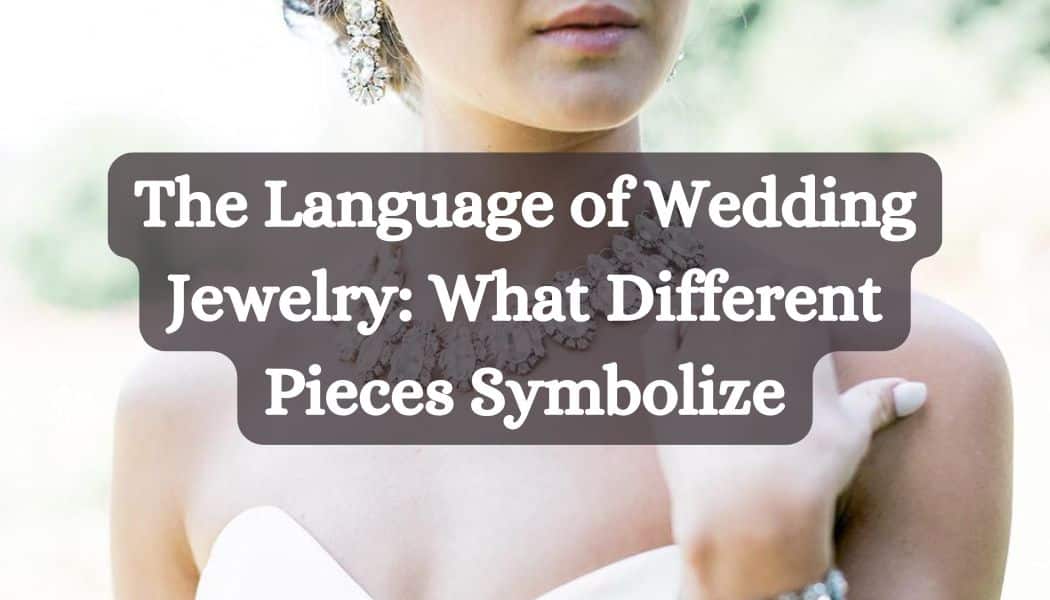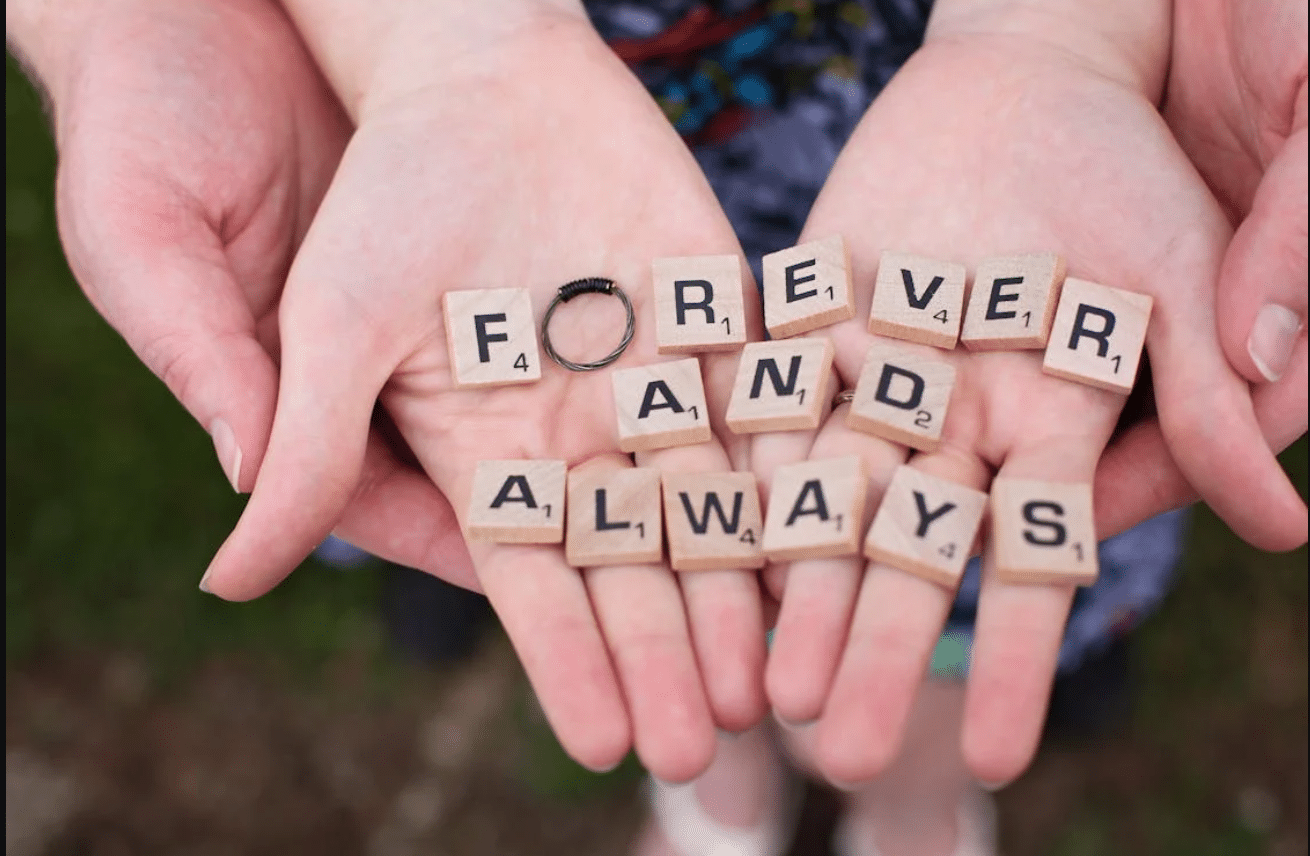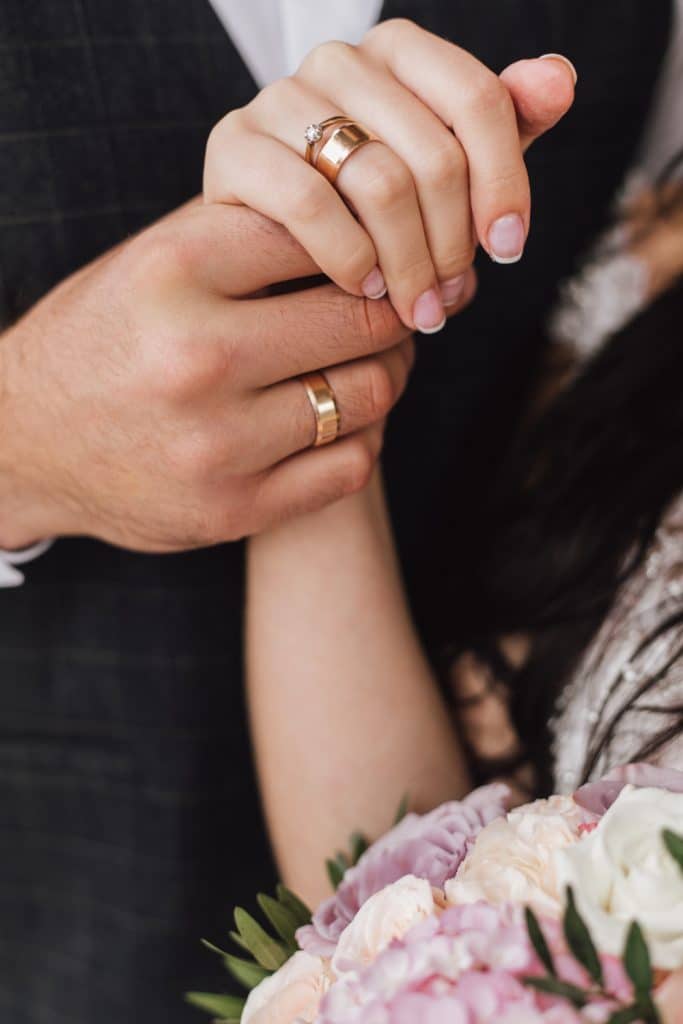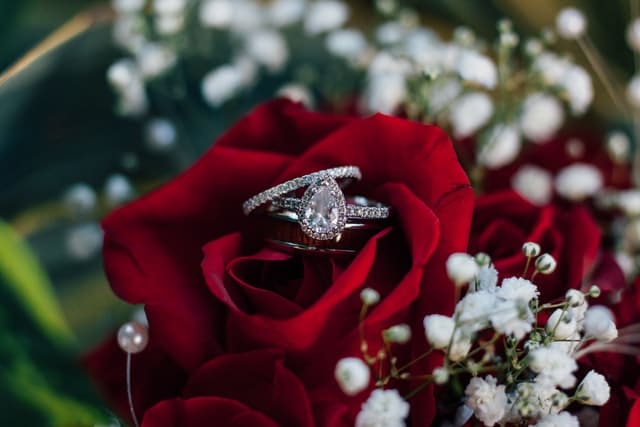
Wedding jewelry tells a story that spans centuries and cultures across the globe. Each piece carries meaning beyond its aesthetic appeal, serving as tangible symbols of love and commitment that endure through time.
Understanding these symbolic languages can help couples choose pieces that truly represent their unique journey together and the promises they make to one another.
Engagement Rings: The First Major Symbol
Engagement rings have announced intentions of marriage since ancient Roman times when simple iron bands were exchanged. The tradition of diamond engagement rings, however, only became widespread in the 20th century after De Beers’ famous marketing campaign that forever linked these sparkling gems with proposals.

Different stones carry their symbolism in engagement rings that speak volumes about the relationship. Diamonds represent endurance and unbreakable bonds, while sapphires symbolize loyalty and wisdom in many cultural traditions.
Emeralds have historically represented fertility and rebirth, making them meaningful choices for couples planning families. Rubies speak the language of passion and protection, symbolizing the heart’s deepest emotions in their rich red hue.
Modern couples often choose alternative stones that reflect personal meaning or ethical values in today’s conscious marketplace. Moissanite, lab-grown diamonds, and family heirlooms have gained popularity as meaningful alternatives that align with contemporary values.
The setting style also communicates different messages about the wearer’s personality and preferences. Solitaires speak to traditional elegance and focused commitment, while halo settings amplify brilliance and vintage appeal for those drawn to elaborate expressions.
Trilogy settings with three stones often represent the couple’s past, present, and future journeys together. Tension settings, where the stone appears suspended, symbolize the strength of the relationship holding precious elements secure.
Cultural Variations in Engagement Traditions
Many cultures have unique engagement jewelry traditions beyond the Western diamond ring that reflect their heritage and values. Irish Claddagh rings incorporate hands, heart, and crown symbols representing friendship, love, and loyalty in a centuries-old design.
In many Scandinavian countries, both partners wear engagement rings as a visual commitment to equality. This balanced approach reflects the egalitarian values many modern couples embrace worldwide, regardless of cultural background.
Chinese couples often exchange jade engagement rings or pendants symbolizing purity and harmony. The specific shade of jade chosen may represent different qualities the couple wishes to bring into their marriage.
Wedding Bands: The Universal Symbol
Wedding bands trace back to ancient Egypt, where circles symbolized eternity without beginning or end. The unbroken circle represents continuity and permanence in the relationship, a visual promise of unending commitment.
Materials chosen for wedding bands carry their language of meaning and practical significance. Gold symbolizes purity and value, while platinum represents strength and endurance for couples seeking something that withstands daily wear.
White gold offers a contemporary look while maintaining traditional symbolism of precious metals. Rose gold speaks a warmer language with its romantic hue, symbolizing the tender aspects of love.
Alternative metals like titanium and tungsten have gained popularity for their durability and contemporary aesthetic. These modern choices often appeal to practical individuals who value longevity and resilience in both their jewelry and relationships.
Many couples personalize bands with engravings of dates, phrases, fingerprints, or heartbeat patterns. These hidden messages create an intimate connection only the couple shares, speaking a private language of love.
Some bands incorporate stones like small diamonds or birthstones that add personal significance. These elements can commemorate special dates or aspects of the couple’s journey together.

The Evolution of Wedding Band Traditions
Historically, only women wore wedding bands in many Western cultures as symbols of their marital status. The tradition of men wearing bands became widespread during World War II, when soldiers wore rings as reminders of their wives at home during long separations.
Today, couples often coordinate their bands while maintaining individual style preferences that suit their tastes. This balance represents unity while honoring individuality within the relationship, a modern approach to traditional symbolism.
Some cultures exchange rings during betrothal rather than wedding ceremonies. This practice highlights the commitment process as a journey rather than a single moment.
Promise Rings: Commitments Before Engagement
Promise rings serve as symbols of commitment before formal engagement, creating a middle ground for developing relationships. They can represent various promises, from future engagement to monogamy or abstinence, depending on the couple’s intentions.
These preliminary commitment pieces often mark significant relationship milestones worth commemorating. Couples may exchange them after dating for a year or when making decisions about their future together.
Traditionally associated with women, promise rings have evolved to reflect more balanced relationship dynamics. Modern couples often choose matching sets, with many women surprising their partners with a men’s promise ring to symbolize mutual commitment before taking the next step in their relationship journey.
Promise rings typically feature more subtle designs than engagement rings to distinguish their different purpose. Simpler bands, smaller stones, or meaningful symbols often characterize these preliminary commitment pieces that speak a quieter language of devotion.
Styles and Meanings
Men’s promise ring styles often incorporate masculine elements like textured metals, hammered finishes, or minimalist designs. Materials range from traditional precious metals to contemporary options like carbon fiber, wood inlays, or even ceramic for a distinctive look.
Some promise rings incorporate birthstones or other meaningful gems that hold personal significance. Others feature symbols like knots, infinity signs, or heartbeats that visually represent commitment.
The timing of exchanging promise rings varies widely between couples depending on their relationship timeline. Some choose significant anniversary dates, while others select meaningful locations or moments that hold special significance in their journey together.
Promise rings can be worn on any finger, unlike engagement and wedding rings that follow stricter traditions. Many men wear these symbols on their right hand to distinguish them from marital jewelry while still honoring their commitment.
For long-distance couples, promise rings serve as physical reminders of connection across miles. These tangible symbols provide comfort during separations and speak to the commitment to overcome distance.
Eternity Rings: Celebrating Ongoing Commitment
Eternity rings feature continuous gemstones symbolizing never-ending love and commitment beyond the wedding day. They traditionally commemorate significant anniversaries or the birth of children, marking relationship growth.
The design speaks to continued devotion through life’s changes and evolutions. Their circular harmony represents the ongoing nature of committed relationships that deepen with time.
Full eternity rings have stones encircling the entire band in an unbroken display of brilliance. Half-eternity designs, with stones across only the visible portion, offer more comfort for daily wear while maintaining symbolic meaning.
The stones chosen for eternity rings often carry special significance beyond their beauty. Birthstones may represent children, while diamonds continue the language of enduring strength in all circumstances.
Many couples choose eternity rings to renew vows or mark relationship milestones after weathering challenges together. This tradition acknowledges that commitment grows and evolves throughout a marriage, gaining depth with shared experiences.
Some cultures present eternity rings after specific years of marriage as part of established traditions. These practices recognize the achievement of lasting commitment in a world where relationships often prove temporary.

Anniversary Jewelry: Marking Milestones
Traditional anniversary gifts follow a yearly material guide, from paper (first) to diamond (sixtieth) in Western traditions. Jewelry incorporating these traditional materials creates meaningful anniversary gifts tied to time-honored symbolism and cultural expectations.
The fifth anniversary traditionally calls for wooden gifts, inspiring wood-inlaid jewelry pieces. The fifteenth anniversary’s crystal tradition inspires clear gemstone jewelry that sparkles with achieved commitment.
Modern anniversary jewelry often breaks from tradition to reflect personal preferences and individual relationship journeys. Custom pieces incorporating meaningful dates, locations, or shared experiences speak a more personal language of celebration.
Milestone anniversaries traditionally call for significant jewelry pieces that mark major achievements. The twenty-fifth (silver) and fiftieth (gold) anniversaries often inspire especially meaningful jewelry gifts that celebrate extraordinary commitment.
Stacking rings have become popular anniversary traditions for marking each passing year. Adding a new ring annually creates a visual timeline of the relationship’s journey, with each band representing another chapter completed together.
Charm bracelets sometimes serve as ongoing anniversary records, with new charms added yearly. Each charm can represent significant events from that year, creating a wearable relationship history.
Family Heirlooms and Inherited Jewelry
Heirloom wedding jewelry carries stories and connections to family history that new pieces cannot replicate. These pieces speak a language of continuity and familial bonds across generations, linking past to present.
Wearing a grandmother’s wedding band connects the wearer to their family legacy. This connection often provides emotional comfort and a sense of belonging within a larger family narrative.
Inherited pieces often undergo modifications to suit modern tastes while preserving their essential character. Resetting stones or reworking metals allows couples to honor tradition while expressing their unique style and contemporary sensibilities.
The emotional significance of family jewelry transcends material value in profound ways. Wearing pieces that belonged to beloved relatives brings their presence into the wedding celebration, even when they cannot attend physically.
For blended families, combining elements from different family heirlooms can symbolize the merging of traditions. This thoughtful approach acknowledges both heritage and new beginnings in reconstituted family structures.
Some couples incorporate small elements of family jewelry into new pieces as subtle connections. A stone from a grandmother’s ring set into a modern design creates a perfect balance of old and new.
Cultural and Religious Jewelry Traditions
Many cultures incorporate specific jewelry traditions into their wedding ceremonies that reflect their heritage. Indian brides often wear elaborate sets including necklaces, bangles, headpieces, and toe rings symbolizing prosperity and protection.
Middle Eastern wedding traditions may include gold sets representing family wealth and security. The number and weight of pieces often speak to the family’s status and investment in the marriage.
Religious symbols frequently appear in wedding jewelry across faiths, connecting the marriage to spiritual beliefs. Christian couples might incorporate crosses, while Jewish traditions include wedding rings without breaks or stones, symbolizing uninterrupted unity.
Eastern Orthodox Christians use “stefana” or wedding crowns during ceremonies that remain important family heirlooms. These crown-like bands symbolize glory and honor bestowed upon the couple as rulers of their new family.
Native American wedding jewelry often incorporates turquoise for protection and blessing in various tribal traditions. These pieces connect couples to cultural heritage and spiritual beliefs that stretch back countless generations.
Maori couples may exchange pendants carved from greenstone (pounamu) representing growth and new life. These pieces carry deep cultural significance and connect the marriage to ancestral traditions.
Creating Personal Jewelry Traditions
Modern couples increasingly create their meaningful jewelry traditions that speak their unique relationship language. Some commission custom pieces incorporating elements from shared experiences or values that hold special meaning.
Couples who met traveling might include small elements representing important locations in their designs. Others incorporate symbols of shared interests, from constellations to musical notation that defines their relationship.
Tattoo rings provide a permanent alternative to traditional wedding jewelry for those seeking unmovable symbols. This emerging tradition speaks to permanence in a very literal sense, with designs ranging from simple bands to elaborate patterns.
Couples with active lifestyles sometimes choose silicone bands for everyday wear in practical settings. Reserving precious metal bands for special occasions creates a practical approach to symbolic jewelry that accommodates modern lifestyles.
Some partners exchange meaningful jewelry beyond rings, like pendant necklaces or bracelets. These alternatives allow for personal expression while maintaining symbolic commitment.
The most meaningful wedding jewelry ultimately speaks the language of the specific relationship it represents. When chosen with intention, these symbols become powerful reminders of commitment and connection throughout the marriage journey.
Conclusion
Wedding jewelry speaks a rich language of symbolism that continues to evolve with changing relationship dynamics. From ancient traditions to modern innovations, these pieces carry meaning beyond their material value as tangible expressions of invisible bonds.
Across cultures and throughout history, humans have used jewelry to mark relationship milestones and commitments. This universal language transcends boundaries while adapting to specific cultural contexts and personal meanings.
The most powerful aspect of wedding jewelry lies in its significance to the couple who exchanges it. Whether following tradition or creating new customs, these symbols should authentically represent your unique relationship journey and promises.
As you select pieces to mark your commitment, consider what language they speak about your relationship values. The most meaningful jewelry will continue communicating your promises for years to come, serving as daily reminders of your chosen path together.












